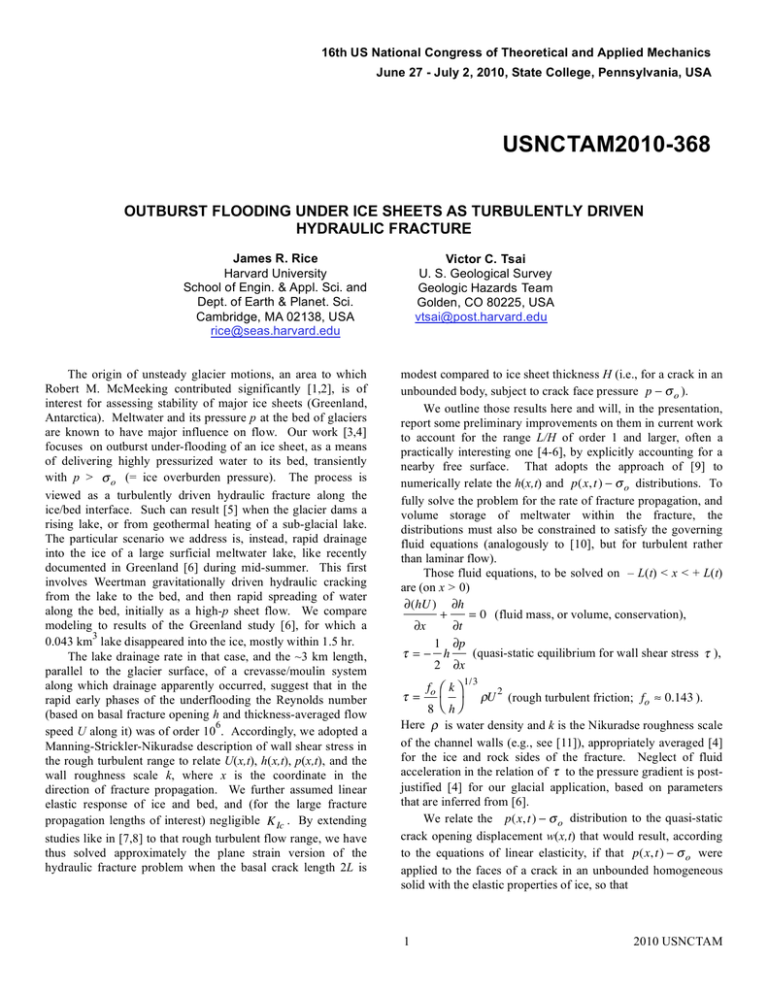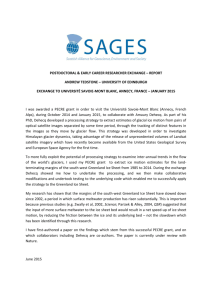Document 12139344
advertisement

16th US National Congress of Theoretical and Applied Mechanics June 27 - July 2, 2010, State College, Pennsylvania, USA USNCTAM2010-368 OUTBURST FLOODING UNDER ICE SHEETS AS TURBULENTLY DRIVEN HYDRAULIC FRACTURE James R. Rice Harvard University School of Engin. & Appl. Sci. and Dept. of Earth & Planet. Sci. Cambridge, MA 02138, USA rice@seas.harvard.edu The origin of unsteady glacier motions, an area to which Robert M. McMeeking contributed significantly [1,2], is of interest for assessing stability of major ice sheets (Greenland, Antarctica). Meltwater and its pressure p at the bed of glaciers are known to have major influence on flow. Our work [3,4] focuses on outburst under-flooding of an ice sheet, as a means of delivering highly pressurized water to its bed, transiently with p > o (= ice overburden pressure). The process is viewed as a turbulently driven hydraulic fracture along the ice/bed interface. Such can result [5] when the glacier dams a rising lake, or from geothermal heating of a sub-glacial lake. The particular scenario we address is, instead, rapid drainage into the ice of a large surficial meltwater lake, like recently documented in Greenland [6] during mid-summer. This first involves Weertman gravitationally driven hydraulic cracking from the lake to the bed, and then rapid spreading of water along the bed, initially as a high-p sheet flow. We compare modeling to results of the Greenland study [6], for which a 3 0.043 km lake disappeared into the ice, mostly within 1.5 hr. The lake drainage rate in that case, and the ~3 km length, parallel to the glacier surface, of a crevasse/moulin system along which drainage apparently occurred, suggest that in the rapid early phases of the underflooding the Reynolds number (based on basal fracture opening h and thickness-averaged flow 6 speed U along it) was of order 10 . Accordingly, we adopted a Manning-Strickler-Nikuradse description of wall shear stress in the rough turbulent range to relate U(x,t), h(x,t), p(x,t), and the wall roughness scale k, where x is the coordinate in the direction of fracture propagation. We further assumed linear elastic response of ice and bed, and (for the large fracture propagation lengths of interest) negligible K Ic . By extending studies like in [7,8] to that rough turbulent flow range, we have thus solved approximately the plane strain version of the hydraulic fracture problem when the basal crack length 2L is Victor C. Tsai U. S. Geological Survey Geologic Hazards Team Golden, CO 80225, USA vtsai@post.harvard.edu modest compared to ice sheet thickness H (i.e., for a crack in an unbounded body, subject to crack face pressure p o ). We outline those results here and will, in the presentation, report some preliminary improvements on them in current work to account for the range L/H of order 1 and larger, often a practically interesting one [4-6], by explicitly accounting for a nearby free surface. That adopts the approach of [9] to numerically relate the h(x,t) and p(x, t ) o distributions. To fully solve the problem for the rate of fracture propagation, and volume storage of meltwater within the fracture, the distributions must also be constrained to satisfy the governing fluid equations (analogously to [10], but for turbulent rather than laminar flow). Those fluid equations, to be solved on – L(t) < x < + L(t) are (on x > 0) (hU ) h + = 0 (fluid mass, or volume, conservation), t x 1 p (quasi-static equilibrium for wall shear stress ), = h 2 x = k 8 h fo 1/3 2 U (rough turbulent friction; fo 0.143 ). Here is water density and k is the Nikuradse roughness scale of the channel walls (e.g., see [11]), appropriately averaged [4] for the ice and rock sides of the fracture. Neglect of fluid acceleration in the relation of to the pressure gradient is postjustified [4] for our glacial application, based on parameters that are inferred from [6]. We relate the p(x, t ) o distribution to the quasi-static crack opening displacement w(x,t) that would result, according to the equations of linear elasticity, if that p(x, t ) o were applied to the faces of a crack in an unbounded homogeneous solid with the elastic properties of ice, so that 1 2010 USNCTAM p(x, t ) o = E w( x , t ) dx + L(t ) 4 L(t ) x x x 2 where E E / (1 ) is the plane strain elastic modulus for the ice; E = Young's modulus and = Poisson ratio. Then, we take h(x, t ) = w(x, t ) to account approximately [4] for effects of the elastic dissimilarity of the ice and underlying rock, giving 0.55 when we assume that the rock has properties comparable to those of granite. The p(x, t ) o distribution is constrained to make K I = 0 . That is appropriate in view of the negligible K Ic of ice (~ 0.1-0.2 MPam) compared to ( pin o ) L for L greater than a few tens of m, at least when pin , the inlet pressure to the crack at x = 0, is comparable to hydrostatic pressure at the base of a water column of height H 1 km [6], extending to the glacier surface. Thus we require that p(x, t ) o + L(t ) dx = 0 . 2 2 1/2 L(t ) [L (t ) x ] That removes any classical r 1/2 stress singularity at the crack 1/7 tips, although there will remain a weak r singularity, understandable [3,4] by an analysis paralleling that of [7]. In the particular case when pin is maintained constant as the crack grows from negligible size, this formulation leads [3,4] to a self-similar solution with L(t ) t fracture propagation speed in that solution is dL pin o 1/2 = 5.14 6 /5 . The resulting 2 /3 1/6 pin o L , E k dt and the average (over –L < x < + L) fracture opening is p o havg = 1.02 in L. E Assuming that the crack volume may be described approximately by using this solution over a width W comparable to the ~3 km length of the feeding crevasse/moulin system, the volume of water stored in the basal crack is 2LhavgW and thus the rate Q at which the crack can take in 7 /6 meltwater is Q = 4Whavg dL / dt , which scales as L 3 3 . Taking W = 3 km, = 10 kg/m , E' = 6.8 GPa [4], and ice thickness H = 980 m [6], assuming hydrostatic p is maintained from the surface lake to the glacial bed so that pin o = 0.87 MPa, and guessing k = 1 cm (because of the 1/6 power, there is weak dependence on k), that predicts Q = 3 4,100 m /s when L = 1 km. Such Q is of comparable order to 3 the maximum drainage rate of 8,700 m /s inferred from the data of [6], and the predicted Q would slightly exceed that maximum rate when L = 2 km. However, we are on shaky ground here, because our solution is only surely correct when L/H is small compared to 1. As remarked, our current work is extending the results outlined here to the realistic range of larger L/H, possibly of order L/H = 5 based on the Greenland field case in [6]. ACKNOWLEDGMENTS Our study was supported by NSF Office of Polar Programs award ANT-0739444, and its presentation here is intended to honor Professor Robert M. McMeeking at the symposium on the occasion of his 60th birthday. REFERENCES [1] McMeeking, R. M., & R.E. Johnson (1985), On the analysis of longitudinal stress in glaciers, J. Glaciology 31(109), 293-302. [2] McMeeking, R. M., & R.E. Johnson (1986), On the mechanics of surging glaciers, J. Glaciology 32(110), 120-132. [3] Tsai, V. C., & J. R. Rice (2008), Hydraulic fracture along glacier beds by turbulent flow of meltwater", Eos Trans. AGU, 89(53), Fall Meet. Suppl., Abstract C31C-0510. [4] Tsai, V. C., & J. R. Rice (2010), A model for turbulent hydraulic fracture and application to crack propagation at glacier beds, J. Geophys. Res. - Earth Surf., in press. [5] Roberts, M. J. (2005), Jokulhlaups: A reassessment of floodwater flow through glaciers, Rev. Geophys. 43, RG1002, doi:10.1029/2003RG000147. [6] Das, S., I. Joughin, M. D. Behn, I. M. Howat, M. A. King, D. Lizarralde, & M. P. Bhatia (2008), Fracture propagation to the base of the Greenland Ice Sheet during supraglacial lake drainage, Science 320, 778-781, doi:10.1126/science.1153360. [7] Desroches, J., E. Detournay, B. Lenoach, P. Papanastasiou, J. R. A. Pearson, M. Thiercelin, & A. Cheng (1994), The crack tip region in hydraulic fracturing, Proc. R. Soc. Lond. A 447, 39–48. [8] Adachi, J. I., & E. Detournay (2002), Self-similar solution of a plane-strain fracture driven by a power-law fluid, Int. J. Numer. Anal. Meth. Geomech. 26, 579–604, doi:10.1002/nag.213. [9] Erdogan, F., G. D. Gupta, and T. S. Cook (1973), Numerical solution of singular integral equations, in Methods of Analysis and Solution of Crack Problems, Recent developments in fracture mechanics, ed. G. C. Sih, pp. 368–425, Leyden, Noordhoff Int. Pub., San Diego. [10] Zhang, X., R. G. Jeffrey, & E. Detournay (2005), Propagation of a hydraulic fracture parallel to a free surface, Int. J. Numer. Anal. Meth. Geomech. 29(13), 1317 - 1340. [11] Gioia, G., & P. Chakraborty (2006), Turbulent friction in rough pipes and the energy spectrum of the phenomenological theory, Phys. Rev. Lett. 96, doi:10.1103/PhysRevLett.96.044502. 2 2010 USNCTAM





